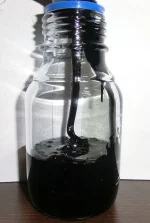I didn’t spend a lot of time on conventional boats, but I thought they made steam with fuel oil. Heavy stuff… heavier than no.2 diesel I believe.
Burn that in boilers, create 1100 PSI to turn the steam turbines, which drive the shafts through planetary reduction gears about the size of my house.
Nukes use the same turbines but they heat with, well, nuke…
The machinery is amazing. The shafts are nearly 300’ long and nearly as big across as my reach.
When they are under full torque, they twist, 360 degrees of twist over their full length.
A 300 foot steel shaft that has one full twist in it is hard to imagine but the boat can do it to reach the speed it needs.
I've taken a few public tours on US Navy destroyers and cruisers, and when I asked what the smell was, I was told that it was JP-5 used to power their turbines. But they use turbines that are just modified jet engines. I'm not sure that was the case though. I'm reading that F-76 fuel used to by the US Navy to power most turbines, although I'm pretty sure they can run on JP-5. This says that a marine turbine can be run off liquified natural gas. It might even be the ideal fuel.
https://www.geaviation.com/sites/default/files/GE-marine-gas-turbine-fuel-flexibility.pdf
My experience discussing fuel oil was with someone at a miniature railway that my kid likes to ride. The chief engineer there said that they power their locomotives with #2 fuel oil, which he said was pretty much just #2 diesel with red dye. He said that in a pinch they could easily use road diesel, but it would cost more. I joked about using bunker fuel once, and he said that stuff is nasty. It has to be heated and burns really, really dirty. We had a ship leak bunker oil in San Francisco Bay, and it was really tough to clean it up.
I did find something saying that the US Navy transitioned from "Navy Special Fuel Oil" (#5 fuel oil aka bunker B) to "Navy Distillate Fuel" (NATO F-76 - pretty much diesel I think) in the 70s. So it wasn't JP-5 like I thought. This is from the late 80s where it sounds like settling on JP-5 for all uses was considered:
In the early 1970s, the U.S. Navy switched from use of Navy Special Fuel Oil NSFO NATO F-77 to Naval Distillate Fuel NATO F-76 in shipboard propulsion and electric generating systems. Presently there are two fuels being utilized in shipboard operations. NDF F-76 is utilized in propulsion and electric generating systems, and JP-5 jet fuel is used for aircraft operations and as an emergency fuel for systems utilizing F-76. Since the conversion from NSFO to F-76, there has been interest in an additional conversion to a shipboard single-fuel operation. Due to the unique requirement of jet aircraft engines, single fuel, from necessity, would have to be JP-5. Therefore, this study was conducted to determine the potential benefits and problems associated with a shipboard single-fuel operation. All shipboard systems, including boilers, turbine engines, and diesel engines should continue to operate satisfactorily, and in some instances, with increased efficiency with JP-5. The greatest benefit from such a conversion would be the convenience of handling only one fuel, and eliminating the possibility of fuel contamination. The major penalties would include higher fuel cost, and difficulty in procuring adequate supplies of JP-5 to meet the total U.S. Navy shipboard fuel requirements.
Here's an article on a former engineer on the Kitty Hawk. Makes it sound like it was a high stress, thankless job keeping the boilers working.
https://www.thedrive.com/the-war-zo...e-life-and-times-of-a-u-s-navy-chief-engineer
